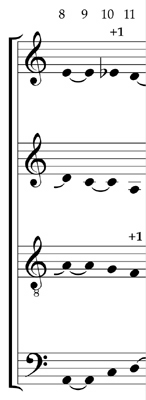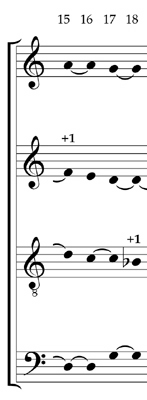Although tuning problems are somewhat exaggerated in the Benedetti and Blackwood examples, “real music” often does contain isolated passages that have no solution satisfying every requirement of pure tuning. The most common case occurs where a note carries over from one chord to another and simply cannot be pure in both. While most of the progressions in the Exercises work beautifully, I have allowed problematic passages to stand, typically with a choice of note that seems to fit best within the mode but that may be momentarily unjust. As noted above, this often means choosing to compromise the minor 3rd, frequently at some point that also includes a dissonance which helps to cover the impurity.
Table 5 shows some of the tuning problem spots in the five exercises. I discuss each one briefly to illustrate where the problem lies and how I decided to resolve the situation.
| Table 5: Problem Spots in the Exercises | |
|
In the G Mode exercise, first of all, note that the C0 in the alto voice at chords 9–10 is not pure in the A0minor triad of chord 9 (to be pure, it ought to be at +1). However, since the C is tied over to chord 10 where it needs to be pure to the modal final of G0, I have placed it at 0 it to be pure to the G. Blackwood would probably have started it at +1 for chord 9 and then changed it to 0 at chord 10. |
 |
|
In the C Mode exercise, at chords 16-17, there is again a problem with the C (in the tenor part). The A is held over the bass’s D, while the C and E are passing. The C should really be at +1 in order to be pure to both the A and the E, but it needs to be at 0 in the next chord to be pure to the G. Since chord 16 is dissonant anyway, the C is tolerable as a narrow minor third. |
 |
|
A similar situation occurs at chord 24 in the D Mode exercise. The soprano’s C is suspended at +1 from the previous chord, and the E is passing. In order to be pure to the G in the bass and alto, the C should be at 0 and the E at –1. Given that as a suspension the C must be at +1, the E needs to stay at 0. The fact that the chord is a passing second inversion makes it less unpleasant. |
 |
|
At chord 29, also in the D Mode exercise, the E, G#, and B are all pure to one another approaching the cadence to A at chord 30, but the D should technically be at +1 in order to be a pure minor third above the B. It must remain at 0 because it’s tied over from chord 28, however, and in fact, the linear motion is preferable this way to the extremely wide semitone of D+1descending to C#-1. In any case, D0 to G#-1 is a better tritone than D+1 to G#-1, and since the D is also dissonant to the E, the impurity is not so noticeable. This does raise the question of what to do with dominant seventh chords when they occur in later music, since those same impurities will always be an issue. |
 |
|
In fact, the problem in the A/E Mode example is similar. The bass’s F+1 in chord 25 is pure to both the B and the D; however, the B and D are not pure to each other. The B needs to remain where it is as the note above the eventual cadence tone, A. The D could conceivably be placed at +1 to be pure to the B0, but then it would be impure to the F+1, and would no longer make a pure tritone with the G#-1 in chord 26. Obviously, there is a fundamental problem in trying to tune diminished triads (an important component of dominant sevenths chords as well): two pure minor thirds do not make a pure diminished fifth. This is one of the reasons I don’t think Just intonation works well for most baroque music.Fn36 |
 |
|
Finally, in the F Mode example, the consecutive fourths in the bass mean that G, D, and A are all at 0. This is fine, and the parts work out well vertically as well as horizontally, but the result is that F in chord 18 is at +1, which seems an odd place to find the final of the mode. The fact that the piece has turned toward D Mode at that point explains the comfortable placement of F at +1 in this passage, a pure minor third above the temporary modal center |
 |
With more experience and expertise, singers can perhaps experiment with different solutions from the ones given here, including “mid-note” alterations like those used by Easley Blackwood. Used subtly, with discreet sliding rather than abrupt changes in pitch, and covered by a softer dynamic, such adjustments might well represent a possible compromise between his approach and mine. Nevertheless, I suppose the very existence of such problem spots allows skeptics to continue to maintain that Just intonation is, after all, a merely theoretical system that cannot work in practice. However, I believe a serious attempt to master the approach represented by these exercises will bear fruit, and further, that the overwhelming beauty of works performed in this way—even with occasional problem spots—will amply reward performers and listeners alike, and “justify” the effort. And even if singers are unable to match the exact theoretical positions of the notes in Just intonation, the fact that they are aware of the system and come somewhat closer to Just ratios should still make their singing “better in tune” according to the criteria expressed so unanimously during the Renaissance.
Footnotes
36. For my views on early 18th-century ensemble tuning, see my “Why I hate Vallotti (or is it Young?),” Historical Performance Online (2000), and my aforementioned forthcoming article and practice resource, “Baroque Ensemble Tuning in Extended 1/6 Syntonic Comma Meantone,” Digital Case (2006). For an discussion of unequal tuning procedures through the 19th century, see my How Equal Temperament Ruined Harmony (and Why You Should Care), forthcoming from W. W. Norton, 2006.
